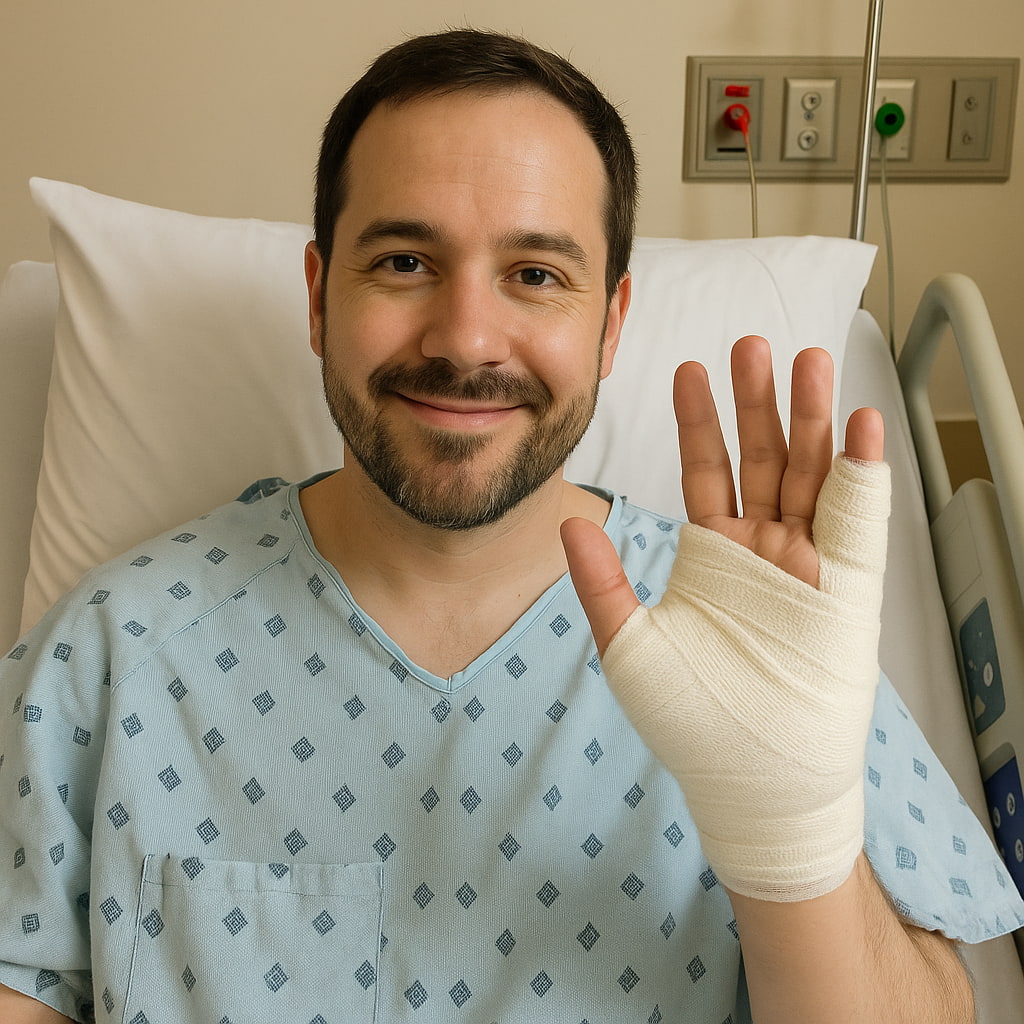See Also:
Rehabilitation Goals
- Protect surgical site and promote wound healing
- Restore finger extension and hand function
- Reduce swelling and manage scar tissue
- Improve strength and dexterity of the hand
- Prevent recurrence and promote long-term hand health
Expected Recovery Time
| Milestone | Timeframe Range |
|---|---|
| Wound healing complete | 10–14 days |
| Begin full range of motion | 3–6 weeks |
| Return to light daily tasks | 4–6 weeks |
| Resume normal grip strength | 8–12 weeks |
| Return to manual labour | 10–16 weeks |
Phase 1: Early Post-op (0–2 weeks)
Goals
- Protect the surgical site
- Control swelling and pain
- Maintain finger and hand movement where permitted
Instructions
- Keep the hand elevated above heart level whenever possible
- Keep the wound clean and dry
- Follow your surgeon’s instructions on dressing and splint care
- Ice may be applied indirectly (not directly on incision) for 10–15 minutes as needed to reduce swelling
- Avoid forceful gripping, lifting, or pressure through the hand
Exercises
- Begin gentle range of motion (ROM) exercises for uninvolved fingers and wrist
- Passive and active finger extension and flexion of the operated digits as permitted by your therapist
- Tendon gliding exercises (if cleared by therapist/surgeon)
- Nerve gliding exercises (if recommended)
Phase 2: Mobilization Phase (2–6 weeks)
Goals
- Continue improving ROM and reduce stiffness
- Initiate scar management
- Begin light functional use of the hand
Instructions
- Continue hand elevation and gentle activity
- Scar massage with a moisturizing cream (once incision is fully healed)
- Wear night splint (if prescribed) to maintain finger extension
- Avoid strong gripping or pinching activities
Exercises
- Active and passive ROM exercises to improve finger extension and flexion
- Intrinsic stretching and blocking exercises
- Continued tendon and nerve gliding exercises
- Use of therapeutic putty or light hand therapy tools for dexterity
Phase 3: Strengthening and Function (6–12 weeks)
Goals
- Restore hand strength
- Improve endurance for daily tasks
- Maximize ROM and fine motor control
Instructions
- Resume light household activities as tolerated
- Continue wearing night splint if advised
- Begin light strengthening activities with guidance
Exercises
- Strengthening with putty, hand grips, or resistance bands
- Progressive weight-bearing through the hand
- Coordination and fine motor control drills (e.g. picking up small objects, buttoning)
- Continue ROM and stretching exercises as needed
Phase 4: Advanced Functional Recovery (12+ weeks)
Goals
- Return to full functional use of the hand
- Resume work, sports, or hobbies
- Minimize risk of recurrence
Instructions
- Resume most normal activities, avoiding heavy or repetitive tasks until cleared
- Discontinue splints unless advised to continue
- Continue independent home exercise program
Exercises
- Higher-resistance strengthening
- Job or task-specific training
- Dynamic and functional movement practice
- Ongoing scar tissue mobilization if needed
When to Contact Your Surgeon
- Signs of infection: redness, warmth, increased swelling, or pus
- Fever above 38°C
- Severe or increasing pain not controlled by medication
- Wound dehiscence or reopening of the incision
- Numbness, tingling, or persistent weakness in the hand
- Difficulty extending fingers despite exercises
Disclaimer:
This is a general guideline. Your physiotherapist, hand therapist or Dr Lambers may adjust the protocol based on your specific condition and progress.
